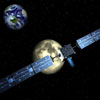 |
||
| Monday / 17 July 2006 | ||
SMART-1 Providing
View of Moon in Unprecedented Detail.
ESA's Smart-1 has been studying the
Moon for 15 months and is returning up to 1,000 images per week,
according to RedOrbit.com.
They show the Moon's surface in unprecedented detail because mission
planners make sure there is enough sunlight to
illuminate a particular lunar feature before
the spacecraft's camera points to it. That's a challenging task as
Smart-1's orbit carries it around the Moon from mid-day to midnight
in just five hours. In addition, Smart-1 Project Scientist Bernard
Foing says, "To decipher the formation and evolution of the Moon,
and the processes that shape its landscapes, we needed both global
coverage and dedicated observations of specific targets." The mission
is using four innovative observing modes: nadir, targeted, Moon-spot
pointing, and push-broom observations. Miguel Almeida, Science Operations
Engineer at ESTEC, says, "The push-broom observations were entirely
successful." It's a technique that allows color images of the Moon
to be made with the AMIE camera. Scientists can create contextual
maps of surface minerals and search for glassy areas depicting meteorite
strikes that have melted small areas. Smart-1 is in the final phase
of its mission, which entails a series of increasingly low altitude
orbits that will allow scientists to study the south pole to see
if there are any possible landing sites for future missions. On 3
September, the probe will intersect the Moon, leaving behind just
a small crater of a few meters in size.
Brief interruptions for two trim maneuvers to
adjust the impact time will take place at the end of July and the
beginning of September.
|
||
